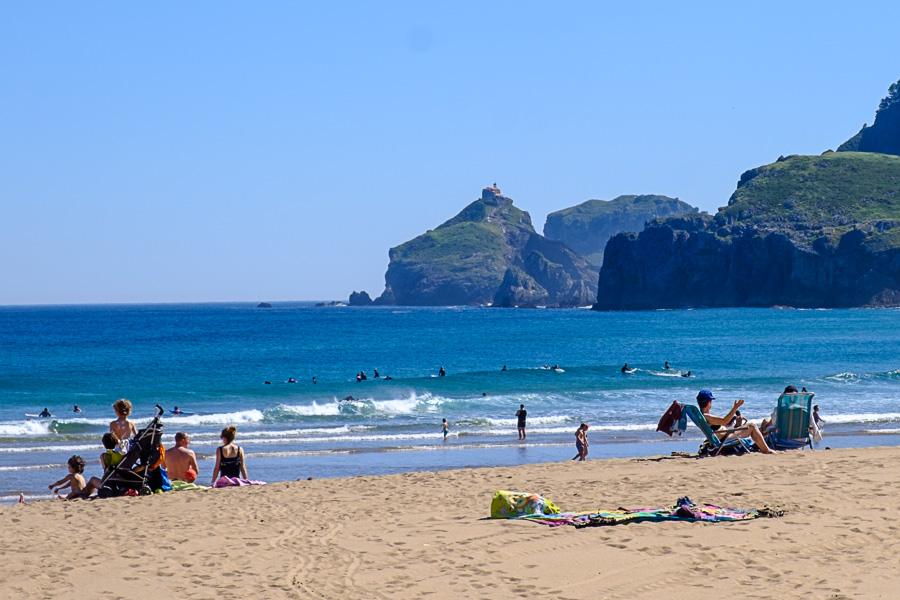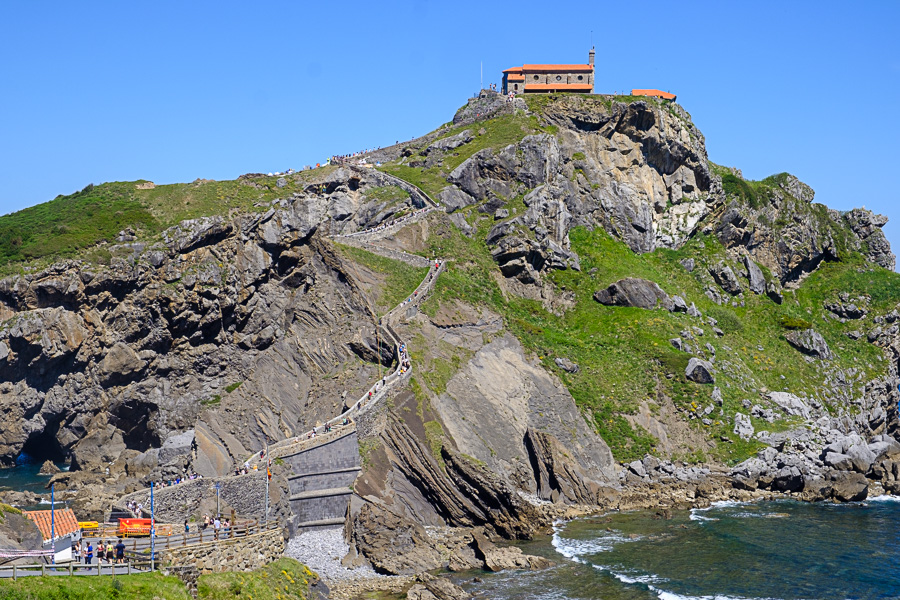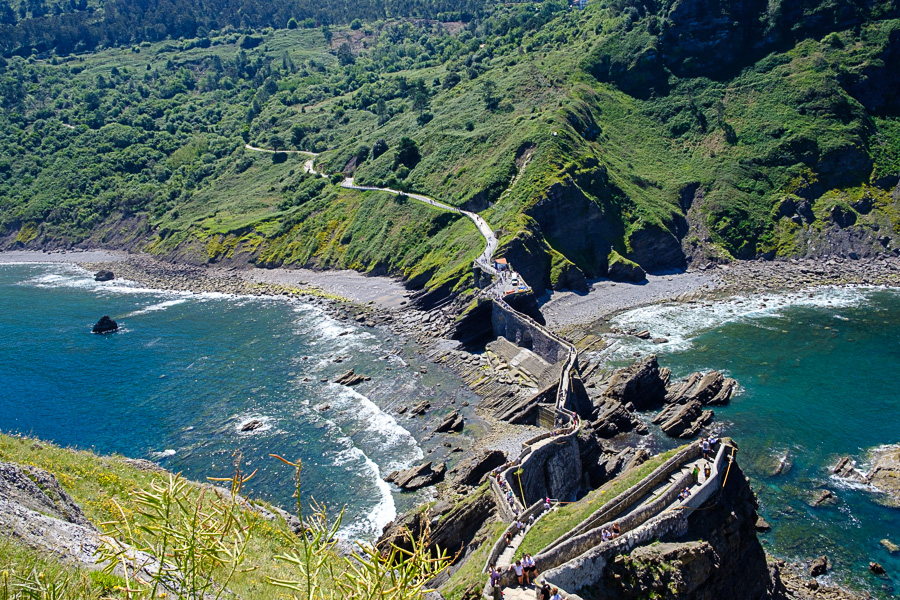We’ll, here’s another place we should have booked for a week instead of a one-night stand. We’ve just checked into a farm house B&B in the heart of French Basque country. Rolling hills, beautiful farms wherever we look with our now-expected cloudless, blue skies. A bit warm – low 90s today.
Google Maps had trouble finding the exact spot but that was virtually the only navigational issue we faced today. We were greeted by a small dog about the size of a size-sixteen tennis shoe. He barked and blocked our way despite the commands of the lady who greeted us. She, it turned out, is the mother-in-law of the owner who speaks only a little English; the mother-in-law speaks none. Fortunately, the boyfriend of the owner’s daughter came; he speaks French, Spanish, Basque and a fair amount of English. He’s learning English through his work as a nurse in Bordeaux.
This is probably the least planned part of our trip. We added it on when Judy noted that we’d had lots of city time but not so much country time – her favorite. So, we tacked on this side trip into the French (north) side of the Pyrenees Mountains. And countryside it is. Every view is picture post card worthy. We’re going out for dinner at 8 PM at a nearby restaurant that serves traditional food of the area.
Our mission today was to see the Spanish side of the Basque region. We’d planned on at least driving through five towns before leaving for France. We bagged three:
Bakio turned out to be a very nice town, but really a beach town. There is a beautiful sand beach, maybe a kilometer long, with high-rise condos its entire length. Reminded me a little of, say, Clearwater Beach, except being on the Biscayne Bay there’s enough wave action for surfing. Being Saturday, the crowds were plentiful. We arrived early enough to snag a primo parking spot. We also tried to find the one cultural highlight of Bakio, a 17thcentury hermitage (small chapel) but either it’s disappeared, or we can’t read the cryptic map so we failed. We did get a nice stroll among the houses of what is really a very nice Basque village.
The big tourist draw in this area is the hermitage at Gaztelugatxe, a small chapel that dates from the ninth and tenth centuries. It was actually sacked by Sir Francis Drake in 1593 and has burned to the ground several times, most recently in 1978. From the sound of it, visiting the hermitage should be a bit like visiting Mont St. Michel in France – a cathedral on a small island connected to shore by a causeway. And that’s exactly what it is except that it’s a small, nondescript building whose only feature is a bell that can be rung by the visitors. I wonder how many video clips of bell ringers hit Facebook or the European equivalents today. The other small difference is that to get there you must first descend maybe a half kilometer on a rather steep trail to the base of the causeway and then climb up 250 stairs (I counted them) to reach the hermitage. The reverse held true to get home: descend then climb.
The temperature today was 90 so Judy, wisely, decided to turn around before making the climb to the chapel. I, unwisely, did it. I’m glad Judy didn’t because there was nothing to see and the views from the coast line are as good as what you get from the islet.
After, I collapsed in the coffee shop with a couple bottles of water while Judy bagged us some Basque-ish sandwiches for lunch. Whatever they were they paired nicely with the Magnum ice cream bars we found at a kiosk outside the coffee shop.
Final stop: Guernica, Spain, a town with a sorrowful past. On April 27, 1937 the town was bombed by the Nazi and Fascist Italian air forces. The raid was carried out at the request of Francisco Franco as part of his drive to capture Bilbao in the Spanish Civil War. Hundreds of civilians were killed (the exact number is subject to debate). Guernica has become a symbol for the horrors of war. Pablo Picasso was commissioned by the Republican government of Spain to create the painting Guernica. Today a tapestry version of the original hangs outside the Security Council chamber at the United Nations in New York City.
Just our luck, we arrived at 3 PM and, naturally, the museum was closed from 2 to 4 PM. We walked around the Assembly House, the seat of parliament for the Bizkaia region, one of the oldest parliaments in Europe, and as such a symbol of the Basque people. It is symbolic not only for historical reasons but even today there exists a strong Basque feeling in this region. In the 1990s the ETA movement was a violent proponent of Basque separation. Even today the feeling of Basque uniqueness is strong.
Then, on to Souraïdel over mostly four-lane Autovias. Even more mountainous and twisty than before, and still posted most of the way at 120 km/hr (72 mph), the route was one of the prettiest we’ve driven so far. Not that the others haven’t been nice; this one was just a little bit nicer.
Dinner’s booked for 8 PM and I’m hoping we can drive a bit to see the countryside beforehand.
- •• After Dinner ***
I told the waiter, “I’m going to sell my house back home and move here so I can eat food this good every day!”
Dinner, at the recommendation of our B&B hosts, was at Hotel Restaurant Euzkadi in Espelette, France. We had a waiter with enough English to get by. Our needs were simple: food and wine from the local region. What we got: a first course of a scrambled egg, bacon and sausage dish with the local Basque red pepper – Espelette pepper it’s called – from the same town as our restaurant. Our B&B hosts actually have a hectare of land on which they grow the pepper – the new plants were just set out recently.
If that was the only dish, we would have gone home happy. But no, we added on a veal dish with potatoes for Judy and a cod and potatoes dish for me. Both were great but I liked mine because it came with a very nice tomato sauce. Dessert? We needed it like a hole in the head, but we had to try the Basque cake. And, of course a bottle of local sweet wine, which we mostly but not completely consumed.
We loved the town of Espelette almost as much as the pepper. We took some snapshots to show you what we mean. Being Saturday night, it looked like the social scene was about to pick up with an outdoor concert.
Tomorrow we’ll take a closer look at Souraïdel before heading south across the Pyranese for Biesla, Spain.









































